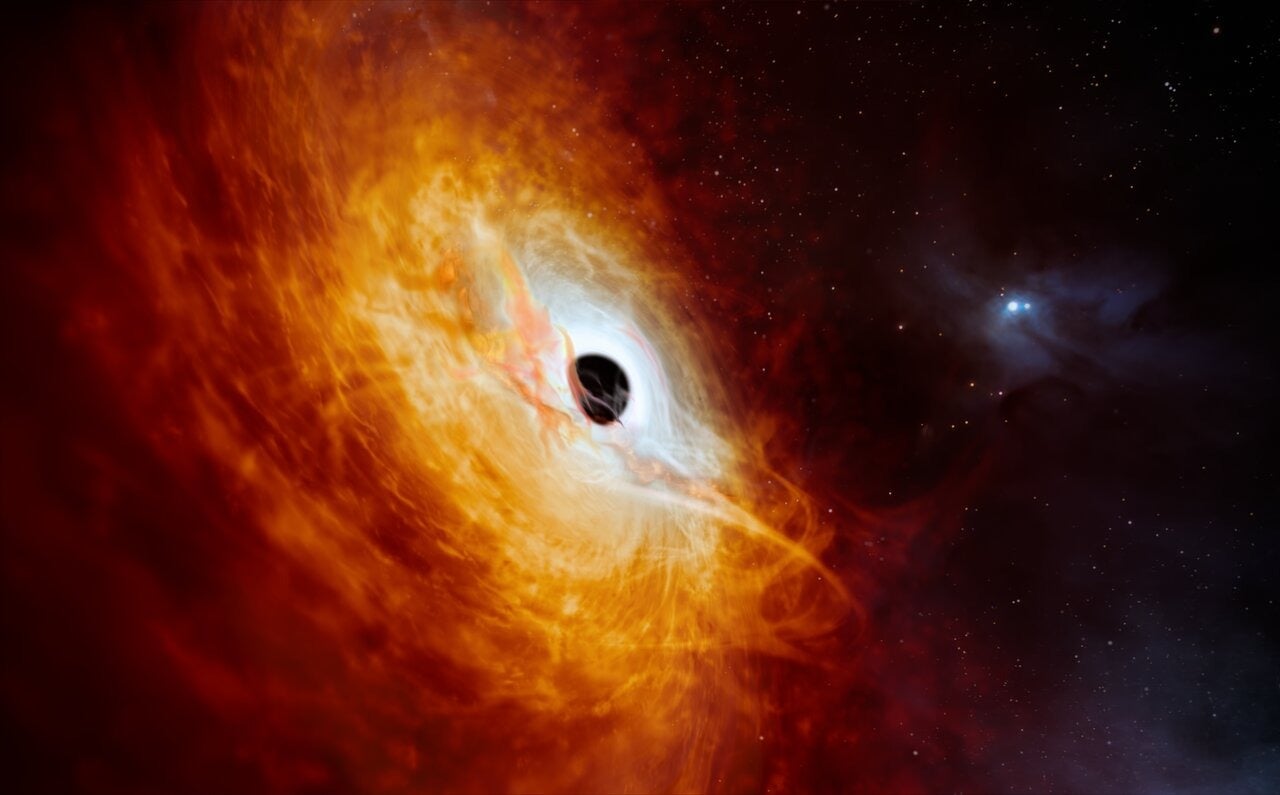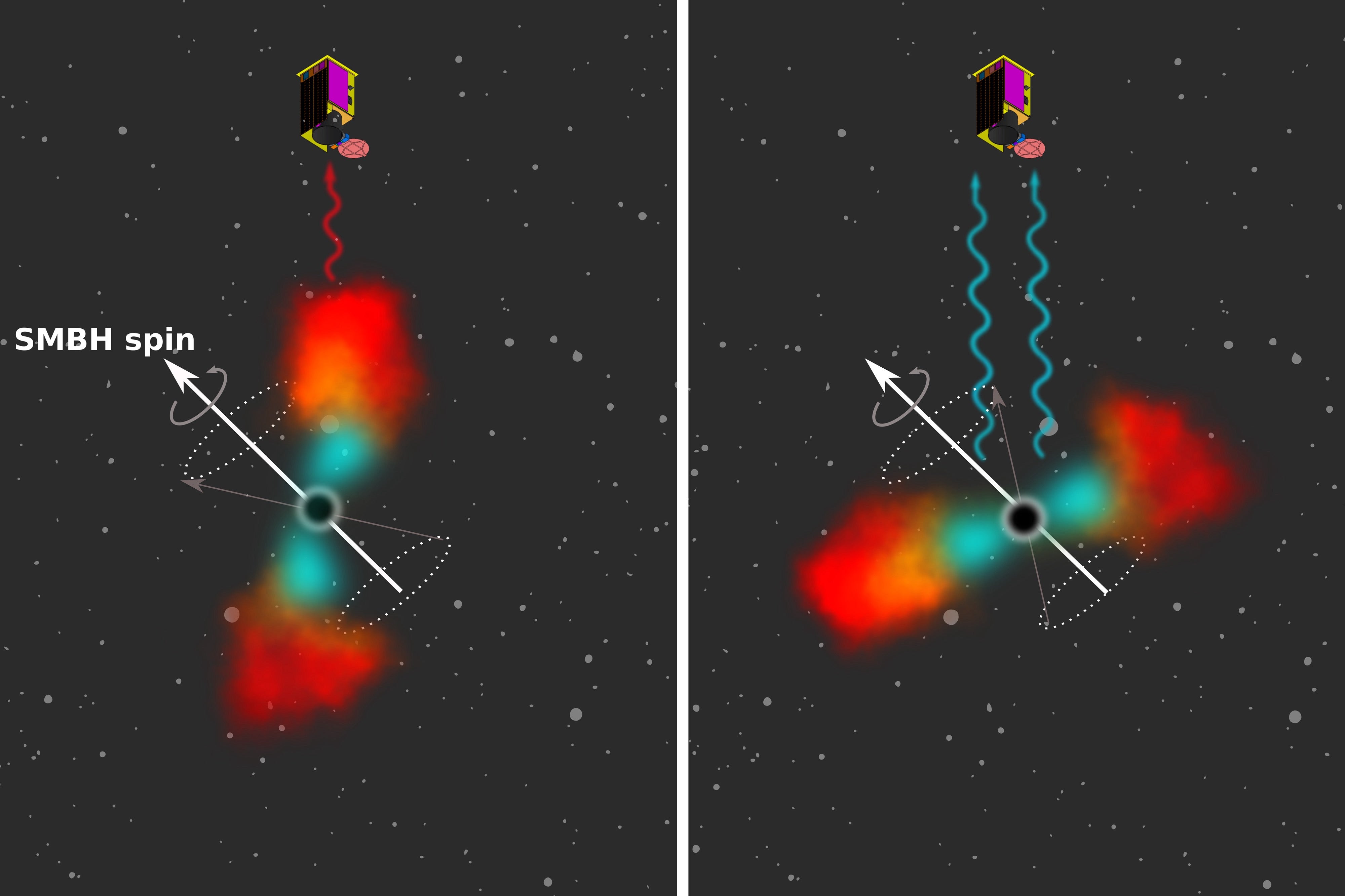
That’s an ingenious impression of record-breaking quasar J059-4351. It’s the sensible core of a distant galaxy that is powered by a supermassive black hole identical to the one studied on this new evaluation. Credit score rating: ESO/M. Kornmesser
Supermassive black holes lie throughout the services of all large galaxies. And a gaggle of astronomers along with researchers from MIT and NASA have, for the first time, measured how briskly actually considered one of these behemoths is spinning. They did so by analyzing the aftermath from the black hole’s present meal of star stuff.
This pioneering methodology makes use of tidal disruption events (TDEs), which occur when a star passes too close to a black hole and is torn apart in consequence. This creates an excellent, rotating disk of stellar supplies throughout the black hole, usually referred to as an accretion disk.
The crew, led by MIT Evaluation Scientist Dheeraj “DJ” Pasham, tracked X-ray flashes from the black hole for a variety of months. These flashes, they concluded, have been generated as a result of the newly created accretion disk bobbled forwards and backwards beneath the have an effect on of the central black hole’s private spin. That’s on account of as a black hole spins, it drags the adjoining material of space-time with it, which can affect shut by objects — akin to an accretion disk. So, by understanding the character of that have an effect on, the crew would possibly in the long run calculate how briskly the black hole is spinning: at a cost of decrease than 25 % the speed of sunshine. Comparatively speaking, that’s pretty sluggish.
Now the technique could possibly be utilized elsewhere to possibly an entire lot of various shut by black holes, based mostly on Pasham. In a press launch accompanying the analysis’s publication, he talked about that “by studying a variety of applications throughout the coming years with this method, astronomers can estimate the overall distribution of black hole spins and understand the longstanding question of how they evolve over time.”
How one can develop a supermassive black hole
Supermassive black holes are, as a result of the title implies, crucial form of black hole. Their lots range from an entire lot of 1000’s to 1000’s and 1000’s and even billions of photograph voltaic lots.
LEARN MORE: How do scientists weigh celestial objects? | Astronomers clock a black hole spinning at half the speed of sunshine
“Black holes develop in two strategies: each by accreting gasoline or by merging with completely different black holes,” James Miller-Jones, a professor on the Curtin Faculty node of the Worldwide Centre for Radio Astronomy Evaluationtells Astronomy.
Nonetheless, exactly how and when supermassive black holes grew to their current dimension should not be clear. “It is tough to develop most likely probably the most large seen black holes throughout the time obtainable,” Miller-Jones says. “A larger understanding of black hole spins would possibly help make clear how a couple of of the cosmic behemoths — black holes of a variety of billion photograph voltaic lots or additional — grew to their seen lots throughout the obtainable time,”
That’s on account of, he says, one of the simplest ways whereby a black hole was grown is mirrored in its spin. Black holes that merely accreted supplies from a safe disk should spin shortly. Nevertheless “additional chaotic accretion, akin to from tidal disruption events, the place the preliminary orbit of the shredded star might need been in any course, is anticipated to lead to lower spins,” he says.
The latter affect is on account of “some [TDE] episodes would spin the black hole in a single course and others within the unsuitable manner,” says Adam Ingram, Lecturer in Astrophysics at Newcastle Faculty throughout the UK.
So complete, Ingram says, measuring black hole spin is thus key to understanding how galaxies long-established and grew in tandem with their central supermassive black hole.
“This analysis finds that the supermassive black hole has a fairly modest spin, implying that it grew by the use of many transient, sharp episodes,” Ingram says.

A useful information steppingstone
Furthermore, Rob Fender, Head of Astrophysics on the Faculty of Oxford, says being able to measure the spin of a black hole and understand the way in which it impacts the space-time spherical it is a key check out of widespread relativity and astrophysics.
“It is hypothesized — and even accepted as a paradigm in some quarters — that you just need a rapidly rotating black hole to provide the extremely efficient relativistic jets we see with radio telescopes. If additional analysis like this might convincingly measure the spins of black holes and study to unbiased estimates of jet vitality, this can be a very important advance,” Fender says.
In spite of everything, black holes are notoriously troublesome to test, notes Michael Nowak, Professor of Physics at Washington Faculty in St. Louis, Missouri. “Black holes give us so few “dimensions” to work with — nearly merely mass and spin, and secondarily age, and probably thirdly the type of galaxy it is in — that attempting to tease apart their variations to know their formation is mainly strong,” he says. “The upper we’re capable of get a cope with on mass, spin, age, and placement — and spin is by far the trickiest of those 4 to ascertain and measure — the upper our prospects of understanding their formation.”
Miller-Jones moreover believes that the strategy developed by Pasham’s crew holds “good promise” for the long term. “Black holes are extreme objects that we can’t recreate in a lab proper right here on Earth. Any enchancment in our understanding of black holes tells us additional regarding the conduct of mass and gravity on probably the most extreme densities,” he says.
Plus, he supplies, this analysis enhances current gravitational-wave work to detect merging black holes, whereas future observations from the anticipated Laser Interferometer Home Antenna, set to launch in a couple of decade, might be succesful to instantly detect merging supermassive black holes.
“Combining the small print about black hole mergers from these gravitational wave observatories with that from electromagnetic analysis akin to this X-ray methodology should significantly improve our understanding of how supermassive black holes develop and evolve over time,” he says.
Related: Black holes for newcomers
